In 2002 Ben Baldanza was a Vice President at US Airways when the airline declared that only full fare tickets would earn elite qualifying miles. Baldanza explained that the people who bought discount tickets weren’t offering the kind of loyalty that the airline was looking for. The decision was quickly reversed, and the airline itself soon in bankruptcy.
Baldanza later became head of Spirit Airlines, and brought Barry Biffle from US Airways along with him. Biffle is now CEO of Frontier Airlines. The two men, alone with investor Bill Franke, remade the ultra low cost carrier side of the U.S. airline industry. Instead of spending money catering to full fare business travelers, they carefully deployed each nickel and charged fees for everything a customer might want, and built a highly profitable business model.
While Ben Baldanza is no longer running a U.S. airline, he actually does blog. And he shared some insights from his time as a Wow Air board member. Wow was the Icelandic transatlantic low cost carrier which collapsed at the end of March.

Wow Air, Copyright: zhukovsky / 123RF Stock Photo
Baldanza argues that too much low cost carrier capacity wasn’t the problem at Wow Air, arguing that while “excess capacity in the North Atlantic markets has kept pressure on prices” Wow Air was in some measure the one driving down prices, and shouldn’t have needed higher fares to be profitable the way a legacy carrier does.
There’s an element of truth to what he says, but I think it misses the point that there was too much capacity at Wow Air’s price point, meaning that:
- Norwegian offered more non-stop service to key European destinations, avoiding Wow Air’s connections through Iceland.
- They competed directly against Icelandair, both for non-stop passengers and connecting ones.
- Traditional carriers lowered their own fares enough to draw customers away from Wow Air even when Wow’s prices were still somewhat lower. The perception was that the inflight experience on Delta or Air France would be better in coach than on Wow Air, you’d get miles, and greater operational reliability too.
It’s not that the prices were too low to make money, it’s that even at the prices Wow Air was charging they couldn’t fill their planes.
Baldanza, though, pins the blame on lack of cost discipline at the airline, though he doesn’t offer specifics. He just points out that the airline’s fast growth should have lowered unit costs but instead increased them (as airline growth often does). He also points out that the carrier burned cash unnecessarily on aircraft, when their Airbus narrowbodies could have been fully financed. This point, though, doesn’t explain why the airline was unable to become profitable — just why they didn’t have cash left to burn through.
One area that he sees as driving too-high costs was an unwillingness to hire cheaper labor. This will be an unpopular point, but Iceland’s labor market is expensive and Wow Air hired Icelandic workers.
Two additional points seem dead-on:
- Iceland is a challenging sole hub. It’s a great market, and a convenient connection city, but it’s got a shorter season than the rest of Europe. Baldanza believes they should have had a second hub that could have succeeded during the winter months. He doesn’t offer any suggested cities, however. Icelandair has made it work but there may not be enough of a market for two hub carriers at Reykjavik.
- The Airbus A330 was too costly an aircraft. They should have focused on narrowbody service, rather than spending more to acquire and fly a widebody that’s more challenging to fill. That would have limited growth to airports closer to their hub, but would have meant lighting less money on fire.


The winter market for LCC’s in Europe is probably Munich, Innsbruck, Milan, Zurich and Geneva to access the ski slopes. I think 3 or 4 of these might have worked but the A321 didn’t have the non stop range from Boston or NY and prices offered by AF, BA, LX, LH and others make them an obvious choice.
I think WOW Air just at the wrong place, wrong time. Traditionally in the past 50 years, airlines are built in the hub model. Large airlines will set up huge national hubs such as DFW, ORD, ATL and then run flights through hubs to connect passengers all across the nation. Same goes for trans-Atlantic flights – legacy carriers all use huge planes such as 747 and 777 to carry over 400 passengers hub to hub and then use smaller regional equipment to fly them to their final destination. It all seems fine and profitable for WOW air to replicate such model and connect passengers at KEF. However, all have changed with the introduction of 787 and A350, with airlines focusing more on point-to-point flights connecting passengers directly to smaller cities. More European and American cities now have direct flights and thus people no longer want to transfer through hubs.